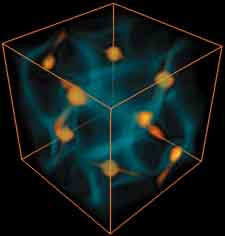
The University of Chicago Magazine
October 1997 |

$20-million government grant gives scientists
access to supercomputers
University researchers will soon be using the world's most
powerful supercomputers to study thermonuclear flashes on old stars. In
a project known as the Academic Strategic Alliances Program, the high-speed
Department of Energy (DOE) computers-60 times more powerful than IBM's Deep
Blue, and 20 times faster than those currently available at universities-will
help the scientists to simulate these explosions, improving their ability
to measure the size of the universe and to understand the production of
heavy ele-ments such as gold and uranium.
"This is an unprecedented opportunity for our scientists
and students to use the most powerful computers in existence to solve some
of the most complex and interesting problems in astrophys-ics," says
David Schramm, vice president for research and an astro-physics professor
at the U of C.
The investigations will also help DOE, which is hoping to
understand how to use the computers to simulate experiments impossible to
enact-such as the detonation of nuclear bombs, which has been banned by
an international treaty. Hoping to better understand how to use its supercomputers
and how to keep the nation's nuclear weapons stockpile safe and reliable
without testing, DOE this  summer awarded access to its
supercomputers to five universities: Stanford, Caltech, the University of
Utah, the University of Illinois, and the U of C. With the access comes
a five-year grant of about $20 million per university, with the expectation
of increasing each grant to $50 million over ten years. The project marks
the first time that the newest supercomputers in the nation's nuclear weapons
laboratories will be available for unclassified university research. summer awarded access to its
supercomputers to five universities: Stanford, Caltech, the University of
Utah, the University of Illinois, and the U of C. With the access comes
a five-year grant of about $20 million per university, with the expectation
of increasing each grant to $50 million over ten years. The project marks
the first time that the newest supercomputers in the nation's nuclear weapons
laboratories will be available for unclassified university research.
A 3D simulation of star formation.
Scientists from the five universities will have access to
approximately ten percent of the computing time on DOE's three new supercomputers:
one at Sandia National Laboratories, currently the world's fastest; and
two being built at Lawrence Livermore National Laboratory and Los Alamos
National Laboratory, which will be three times faster than the Sandia computer.
At Chicago, the grant is being used for the new Center for
Astrophysical Thermonuclear Flashes, in which researchers throughout the
Physical Sciences Division will work with colleagues at Argonne National
Laboratory, operated by the U of C for DOE. Approximately two dozen scientists
and their students will study the physics of the nuclear detonations that
occur when matter in space is crushed by gravity onto the surfaces of extremely
dense stars. The violently exploding stars, or supernovae, emit ten billion
times more power than the sun, and shine as brightly as an entire galaxy
of stars.
Scientists have tried to use supernovae "to measure
the distance to remote galaxies," according to Robert Rosner, a U of
C astrophysics professor and the center's principal investigator. "To
understand the true size of the universe," says Rosner, "we need
to determine whether these incredibly bright objects can be relied on as
the universe's 'standard candles.' This project will allow us to do that."
The U of C project shares many elements of DOE's research
problem, notes Rosner. "The computer science necessary to do our problem
is not all that different from what will be needed for the DOE problems,"
he says. "We also deal with nuclear burning of material at very high
temperatures and densities." He adds that the U of C work on the supercomputers
could even have implications for weather prediction, or yield information
on how air-gas mixtures burn inside engines.
The supercomputers, says Rosner, "are really one of
a kind. This is a fantastic opportunity for university researchers."
Table of Contents - Top of Page
- Email
Us
|
